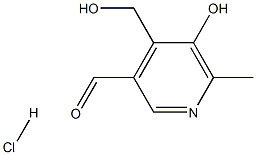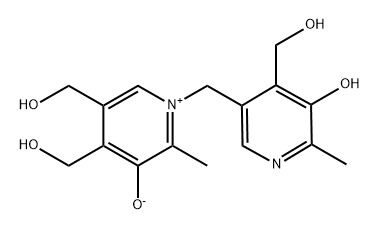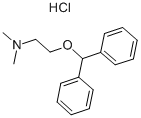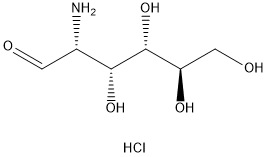Pyridoxal hydrochloride
Synonym(s):3-Hydroxy-5-(hydroxymethyl)-2-methyl-4-pyridinecarboxaldehyde hydrochloride;3-Hydroxy-5-hydroxymethyl-2-methyl-4-pyridinal, HCl;PL HCl;Pyridoxal, Hydrochloride - CAS 65-22-5 - Calbiochem
- CAS NO.:65-22-5
- Empirical Formula: C8H10ClNO3
- Molecular Weight: 203.62
- MDL number: MFCD00012809
- EINECS: 200-602-5
- SAFETY DATA SHEET (SDS)
- Update Date: 2024-12-18 14:08:52

What is Pyridoxal hydrochloride?
Description
Pyridoxal hydrochloride is a hydrochloride salt formed by combining pyridoxal with hydrochloric acid. It is also a derivative of pyridinium salt and vitamin B6. It has important roles in E. coli metabolites, Saccharomyces cerevisiae metabolites, cofactors, human metabolites and mouse metabolites. It can be used as a calibrator for liquid chromatography of food samples, a component of culture media for lactic acid bacteria (LAB) and foodborne pathogens (FBP) (component of arginine decarboxylase and lysine decarboxylase).
Chemical properties
White to off-white crystalline powder
The Uses of Pyridoxal hydrochloride
Pyridoxal hydrochloride is one of the three natural forms of vitamin B6, along with pyridoxamine and pyridoxine. All of these forms are converted in the human body into a single biologically active form, Pyridoxal 5-phosphate (P991715). Green plants are a natural source of Pyridoxal, and its deficiency in the human body can lead to serious complications such as epilepsy and seizures.
The Uses of Pyridoxal hydrochloride
For the labeling of amino acids and their detection in picomolar amounts1; Coenzymes and Cofactors, vol. 1: Vitamin B6, Pyridoxal Phosphate2
The Uses of Pyridoxal hydrochloride
Pyridoxal hydrochloride is used in labeling of amino acids for their detection. It finds application in neurotransmitters, sphingolipids and aminolevulinic acid. It is also used as a nutritional agent. It is also applied in research studies like biochemical, drugs and in media supplements.
What are the applications of Application
Pyridoxal, Hydrochloride is an amino acid labeling agent
Definition
ChEBI: Pyridoxal hydrochloride is a hydrochloride obtained by combining pyridoxal with one molar equivalent of hydrochloric acid. It has a role as an Escherichia coli metabolite, a Saccharomyces cerevisiae metabolite, a cofactor, a human metabolite and a mouse metabolite. It is a hydrochloride, a pyridinium salt and a vitamin B6. It contains a pyridoxal(1+).
General Description
Pyridoxal is a heterocyclic compound, weighing 167.2 Da. It is one of the natural forms of vitamin B6. Pyridoxal is found to be less stable than pyridoxine, hence heating might result in the loss of its action. Pyridoxal has a wide variety of sources and is present in both plants and animals. Pyridoxal serves as an efficient precursor for coenzymes : pyridoxal phosphate and pyridoxamine phosphate.
Biological Activity
Pyridoxal hydrochloride,the 4-carboxyaldehyde form of vitamin b6 which is converted to pyridoxal phosphate which is a coenzyme for synthesis of amino acids, neurotransmitters (serotonin, norepinephrine), sphingolipids, aminolevulinic acid.
Biochem/physiol Actions
Vitamin B6 plays a key role in metabolism of both carbohydrates and amino acids. It is implicated in the synthesis of neurotransmitters like dopamine from L-DOPA, serotonin from 5-HTP, and γaminobutyric acid (GABA) from glutamate. Vitamin B6 plays a major role in maintenance of a healthy nervous system.
Safety Profile
Poison by intramuscular, intravenous, and intraperitoneal routes. Moderately toxic by ingestion and subcutaneous routes. When heated to decomposition it emits very toxic fumes of NOx and HCl. See also ALDEHYDES.
Synthesis
In
the 25mL reaction flask with agitator and thermometer, add successively
0.085g (0.5mmol) 2,2,6,6-tetramethyl piperidine-nitrogen-oxyradical,
0.29g (2mmol) cupric bromide, 0.40g (5mmol) pyridine and 2.06g (10mmol)
pyridoxinehydrochloride. Add
water 5mL, temperature is controlled at 30 DEG C, opens and stirs.Then
drip 2.0g (18mmol) 30% hydrogen peroxide, control temperature of
reaction at 30~35 DEG C simultaneously.After dropwising, insulation
continues to stir 1~2 hour at 30~35 DEG C, and gained reaction solution
reaches 99% (liquid-phase condition: chromatographic column is XDB-G8
250 × 4.6 mm 5um through Liquid Detection pyridoxol transformation
efficiency.Moving phase is methyl alcohol: buffer=15: 85; Buffer:0.04%
sodium pentanesulfonate is adjusted PH to 3 with Glacial acetic acid;
Detection wavelength is 284nm), reaction preference is 98%.
In
addition, get about 5mL reaction solution and directly go up silicagel
column, eluent is methylene dichloride: methyl alcohol=20: 1, obtain
final elutriant through gradient elution, and be concentrated into
dryly, can obtain white solidpyridoxalhydrochloride, fusing point 164.1-164.8 DEG C, nuclear-magnetism characterizes as follows: 1hNMR (400MHz, DMSO), δ: 8.27 (s, 1H, CHO), 6.63 (d, 1H, CH), 5.00-5.16 (m, 2H, CH2), 2.62 (s, 3H, CH3).
Because pyridoxalhydrochloride is unstable, difficult separation, reaction solution
then adds p-ethoxyaniline 1.37g (10mmol), treated yellow Schiff alkali
(IX) 2.10g that obtains without separating.The total recovery of
two-step reaction is 88%.
Purification Methods
Dissolve it in water and adjust the pH to 6 with NaOH. Set aside overnight to crystallise. The crystals are washed with cold water, dried in a vacuum desiccator over P2O5 and stored in a brown bottle at room temperature. The free base is then converted to the hydrochloride with one equivalent of HCl. [Fleck & Alberty J Phys Chem 66 1678 1962, Beilstein 21/13 V 44.]
Properties of Pyridoxal hydrochloride
| Melting point: | 173 °C (dec.)(lit.) |
| storage temp. | 2-8°C |
| solubility | DMSO (Slightly), Methanol (Slightly), Water (Slightly) |
| form | Powder |
| color | White |
| Water Solubility | Soluble in water and ethanol. |
| Sensitive | Hygroscopic |
| Merck | 14,7978 |
| BRN | 3656994 |
| CAS DataBase Reference | 65-22-5(CAS DataBase Reference) |
| EPA Substance Registry System | Pyridoxal hydrochloride (65-22-5) |
Safety information for Pyridoxal hydrochloride
| Signal word | Warning |
| Pictogram(s) |
 Exclamation Mark Irritant GHS07 |
| GHS Hazard Statements |
H303:Acute toxicity,oral |
| Precautionary Statement Codes |
P270:Do not eat, drink or smoke when using this product. P301+P312:IF SWALLOWED: call a POISON CENTER or doctor/physician IF you feel unwell. P403:Store in a well-ventilated place. |
Computed Descriptors for Pyridoxal hydrochloride
| InChIKey | FCHXJFJNDJXENQ-UHFFFAOYSA-N |
New Products
4-Fluorophenylacetic acid 4-Methylphenylacetic acid N-Boc-D-alaninol N-BOC-D/L-ALANINOL Tert-butyl bis(2-chloroethyl)carbamate 3-Morpholino-1-(4-nitrophenyl)-5,6-dihydropyridin- 2(1H)-one Furan-2,5-Dicarboxylic Acid Tropic acid S-2-CHLORO PROPIONIC ACID ETHYL ISOCYANOACETATE 2-Bromo-1,3-Bis(Dimethylamino)Trimethinium Hexafluorophosphate (6-METHYL-[1,3]DITHIOLO[4,5-b]QUINOXALIN-2-ONE INDAZOLE-3-CARBOXYLIC ACID 4-IODO BENZOIC ACID (2-Hydroxyphenyl)acetonitrile 4-Bromopyrazole 5,6-Dimethoxyindanone 2-(Cyanocyclohexyl)acetic acid 4-methoxy-3,5-dinitropyridine 2-aminopropyl benzoate hydrochloride 1-(4-(aminomethyl)benzyl)urea hydrochloride diethyl 2-(2-((tertbutoxycarbonyl)amino) ethyl)malonate tert-butyl 4- (ureidomethyl)benzylcarbamate Ethyl-2-chloro((4-methoxyphenyl)hydrazono)acetateRelated products of tetrahydrofuran








You may like
-
 Pyridoxal Hydrochloride CAS 65-22-5View Details
Pyridoxal Hydrochloride CAS 65-22-5View Details
65-22-5 -
 Pyridoxal hydrochloride CAS 65-22-5View Details
Pyridoxal hydrochloride CAS 65-22-5View Details
65-22-5 -
 Pyridoxal HCl 98% (HPLC) CAS 65-22-5View Details
Pyridoxal HCl 98% (HPLC) CAS 65-22-5View Details
65-22-5 -
 Pyridoxal hydrochloride CAS 65-22-5View Details
Pyridoxal hydrochloride CAS 65-22-5View Details
65-22-5 -
 Pyridoxal hydrochloride CAS 65-22-5View Details
Pyridoxal hydrochloride CAS 65-22-5View Details
65-22-5 -
 Pyridoxal hydrochloride CAS 65-22-5View Details
Pyridoxal hydrochloride CAS 65-22-5View Details
65-22-5 -
 Pyridoxal hydrochloride CAS 65-22-5View Details
Pyridoxal hydrochloride CAS 65-22-5View Details
65-22-5 -
 Pyridoxal, Hydrochloride CAS 65-22-5View Details
Pyridoxal, Hydrochloride CAS 65-22-5View Details
65-22-5